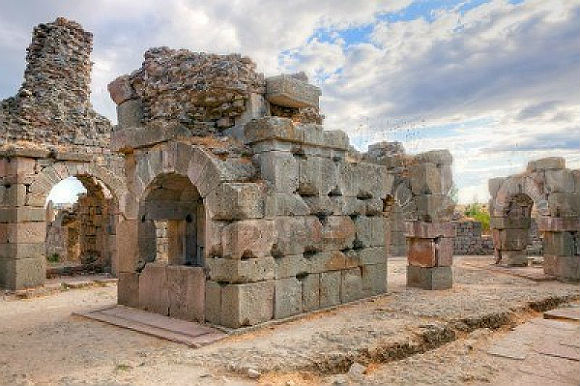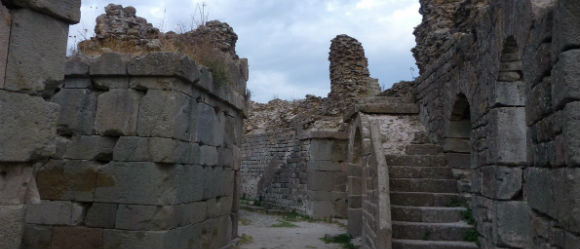An ancient medical centre, the Asclepion was founded by Archias, a local who had been cured at the Asclepion of Epidaurus (Greece). Treatments included mud baths, the use of herbs and ointments, enemas and sunbathing. Diagnosis was often by dream analysis.
Pergamon‘s centre came to the fore under Galen (AD 131–210), who was born here and studied in Alexandria, Greece and Asia Minor before setting up shop as physician to Pergamum’s gladiators. Recognised as perhaps the greatest early physician, Galen added considerably to knowledge of the circulatory and nervous systems, and also systematised medical theory. Under his influence, the medical school at Pergamum became renowned. His work was the basis for Western medicine well into the 16th century.
The Asclepion is 2km uphill from the town centre as the crow flies (but it’s a winding road), signposted from Cumhuriyet Caddesi just north of the tourist office and PTT. A second road runs from Böblingen Pension, southwest of town. It’s closed to motorists and we don’t recommend walking it, as it passes through a large military base; if you do, be off it by dusk and don’t take photos.
A Roman bazaar street, once lined with shops, leads from the entrance to the centre, where you’ll see the base of a column carved with snakes, the symbol of Asclepios (Aesculapius), god of medicine. Just as the snake sheds its skin and gains a ‘new life’, so the patients at the Asclepion were supposed to ‘shed’ their illnesses. Signs mark a circular Temple of Asclepios, a library and, beyond it, a Roman theatre.

Underground access to the Temple of Telesphorus in Roman city Pergamon. The Asklepion of Pergamon was something in between a sanctuary and a spa resort.
You can take a drink from the sacred well, although the plastic tube out of which the water flows doesn’t look particularly inviting, and pass along the vaulted underground corridor to the Temple of Telesphorus, another god of medicine. Patients slept in the temple hoping that Telesphorus would send a cure or diagnosis in a dream. The names of Telesphorus’ two daughters, Hygeia and Panacea, have passed into medical terminology.
Asclepion,


I recommend The Acropolis is a very impressive site ruins of Asklepion. You can enjoy spectacular views both from Acropolis to the valley and from Asklepion to the Acropolis. Despite the fact that the Great Altar of Zeus of Pergamon is transported to Pergamon Museum of Berlin, the basement is still in Acropolis.
I highly recommend this ruins and you…
It is pretty easy to imagine the layout of the Asklepion of ancient Pergamon (now close to the modern city of Bergama). An Asklepion is a healing temple, possibly the equivalent of a hospital or perhaps more closely a spa. The main entrance is reached by walking up a long walkway which would have had pillars on either side (there…
Triggered thoughts of how the ancients healed . . . and didn't. So much to learn, still.
Most of these sites have a signature reconstructed temple or so, a stadium, and assorted scattered blocks. So pick a couple of interesting ones – but don't try to do them all.
From the front, this looks like just a bunch of pillars. But when you reach the back side of the area, it opens up to reveal some crazy ruins. Things like a treatment room where they reportedly used mystical ceremonies to do the healing, a temple to Zeus (long gone by now), an old bath, a theater, and more. A…
The Asclepion (Asklepieion) of Pergamum was once the world's most famous ancient medical center, and is the second-most important site in modern Bergama. It lies on the plain below the ancient acropolis of Pergamum, just over one kilometer west of the modern city, beside a large Turkish army base.
Founded by a man named Archias, the Asclepion of Pergamum became…
Ruins of Asklepion, including a smaller theatre, paved road and a lot of remains of different structures, are down in the valley beneath the Acropolis. You can enjoy spectacular views both from Acropolis to the valley and from Asklepion to the Acropolis. We found it dificult to find a good alternative for lunch in the nearest town of Bergama, even…
Seemed more like a health spa than a hospital… Plus they did not admit pregnant women or terminally ill. The site was interesting but I found that the 15TL entry left me expecting more than I got.
This was a nice, smaller attraction…you can easily see everything here in about 45 minutes. The price of admission (15 TL) was quite high, especially relative to the Acropolis (20 TL) which was much larger. The ruins are interesting and the information panels are pretty good, but it would have been helpful to have a bit more detail in a…
History is all about perspective. When you see your feet standing on ground where others stood 2300 years ago and practiced psychoanalysis, dream interpretations, the importance of internal, physical cleansing, addressing mental health issues–very cool to actually visit this site that embraced all these 'new' age ideals. Grecian influence on the world is mind boggling!!